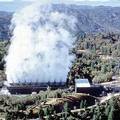 美國內政部長坎培松(Dirk Kempthorne)表示,在西岸各州共超過1.9億公頃的聯邦領地將開始開發地熱能資源。坎培松說:「地熱將扮演啟動美國能源前景的關鍵角色。現在美國境內已發現的地熱資源,有九成在聯邦領地中。」
美國內政部長坎培松(Dirk Kempthorne)表示,在西岸各州共超過1.9億公頃的聯邦領地將開始開發地熱能資源。坎培松說:「地熱將扮演啟動美國能源前景的關鍵角色。現在美國境內已發現的地熱資源,有九成在聯邦領地中。」
這項名為「地熱環境影響總結綱要報告」(Final Geothermal Programmatic Environmental Impact Statement) 的開發計畫,將劃定出由土地管理局管理約1億1800萬公頃的公有地、以及美國國家森林處管轄的7900萬公頃土地,作為未來開發地熱租賃。
坎培松在鳳凰城出席美國印地安人年度全國大會時表示:「提供美國家庭與工商所需安全、乾淨的能源,根據整體環境健全的規範來推行地熱租賃與地熱發展是十分重要的。」
目前土地管理局設立在加州、內華達州和猶他州共29座地熱發電廠已開始運作,總裝置容量達1250MW,足以供給120萬家庭用戶的電力需求。其中加州地熱場裡的The Geysers是世界上最大的地熱發電廠機組,然而它所能供給的能量還不到全球所蘊含地熱能的百分之一。
根據這項計畫,至2015年,新設立的地熱能電場總裝置將達到5540MW(百萬瓦特)。以每1MW能供給超過1000戶家庭用電來看,如果這項計劃成功實行,地熱發電將供足550萬用戶所需。
此計劃也預期,至2025年總裝置容量將達到12100MW,可提供超過1200萬家庭的電力。
坎培松指出,從近來土地管理局依據資源管理計畫(Resource Management
Plans)已核准開發的地熱地區的租出統計看來,開發地熱資源已經引起越來越多興趣。
例如The Geysers每公頃單價在2007年8月達到有史以來最高,2008年8月內華達州出租的地熱地也創下2820萬美金的高價。
坎培松說,有強烈發展興趣的各州政府、地方社區、工商業與環境團體都共同參與此項計畫的發展。
他表示,地熱發展已經從政府與非政府相關利益者的參與、以及美國國會2005年能源政策法案裡清楚明瞭的方針中獲益匪淺。
然而地熱能仍尚存隱憂。乾式地熱發電(Dry steam power plants)與突發式地熱發電(flash steam power plants)仍會噴發出少量二氧化碳、一氧化氮和硫,雖然只有化石燃料發電的5%。
而地熱源產生的熱水會夾帶所經之處的汞、砷等有毒物質,流入河水後使飲水品質堪慮。
為了保護特殊資源,這項地熱開發計畫也為未來地熱租賃訂定出各種規範、核准條件及其所需的最佳管理方案。
土地管理局與美國林務署在24日已於聯邦法規資料庫(Federal Register)中公布此計畫的最終定案,詳情請參考網站:http://www.blm.gov/Geothermal_EIS
More than 190 million acres of federal land in 12 western states will be opened for development of geothermal energy resources, Secretary of the Interior Dirk Kempthorne announced today.
"Geothermal energy will play a key role in powering America's energy future,"Kempthorne said, "and 90 percent of our nation's geothermal resources are found on federal lands."
The plan would identify about 118 million acres of public lands managed by the Bureau of Land Management and 79 million acres of National Forest Service lands for future geothermal leasing.
"Facilitating their leasing and development under environmentally sound regulations is crucial to supplying the secure, clean energy American homes and businesses need," the secretary said in Phoenix where he has been attending the annual convention of the National Congress of American Indians.
There are 29 geothermal power plants currently operating on Bureau of Land Management lands in California, Nevada and Utah, with a total generating capacity of 1,250 megawatts, enough to supply the electricity needs of 1.2 million homes.
The largest group of geothermal power plants in the world is located in The Geysers, a geothermal field in California. Currently, geothermal power supplies less than one percent of the world's energy.
Under the plan announced today, known as the Final Geothermal Programmatic Environmental Impact Statement, 5,540 megawatts of new electric generation capacity from geothermal resources could be in place by 2015.
One megawatt of geothermal energy powers more than 1,000 homes, so if the newly announced plan is implemented, new geothermal energy could meet the needs of 5.5 million homes.
In addition, the plan estimates an additional 6,600 megawatts by 2025 for a total of 12,100 megawatts - enough to power more than 12 million homes.
Kempthorne points to growing interest in developing these resources shown by the results of recent Bureau of Land Management geothermal lease sales in areas where current Resource Management Plans already allow geothermal development.
An August 2007 sale drew the highest ever per-acre bid for a lease in The Geysers field. And a sale of leases in Nevada brought a record-breaking $28.2 million in August 2008.
Kempthorne noted the strong interest states, local communities, industry and environmental groups took in the development of this plan.
"This process has benefited greatly from the involvement of both governmental and nongovernmental stakeholders, and from the clear direction Congress gave in the 2005 Energy Policy Act," the secretary said.
There are environmental concerns around geothermal energy. Dry steam and flash steam power plants emit low levels of carbon dioxide, nitric oxide, and sulphur, although at roughly five percent of the levels emitted by fossil fuel power plants.
Hot water from geothermal sources will contain trace amounts of toxics such as mercury and arsenic, which if discharged into rivers can make the water unsafe to drink.
To protect special resource values, the plan announced today identifies a comprehensive list of stipulations, conditions of approval and best management practices required for approval of future geothermal leases.
The Bureau of Land Management and the U.S. Forest Service will publish the final version of the plan in the Federal Register on Friday, October 24, 2008.
It will be available online at http://www.blm.gov/Geothermal_EIS.






